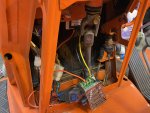I just recently replaced my tractors belt drive fan for an electric fan and it yielded the opposite effect I was hoping for. Instead of it keeping the temps lower, it started overheating the engine. The fan I'm using is a Spal 30100435. It's a 10 inch fan, and fits pretty well in the radiator shroud. I did have to do a bit of jerry rigging to get it to fit, but nonetheless, it fits. I checked the thermostat and it opens like it should. The radiator is fine to my knowledge, as it was working fine before I changed the fan. It is still pulling air like the belt drive, and it is moving 10x as much air, but the engine is getting hotter than normal. Now, I know you're asking why would I change it if it wasn't broke. Well, I plan to add more power in the future by adding more fuel by advancing the timing on the pump, and also adding a turbo. I wanted cooling to be very efficient before messing with the engine. If anyone has any clue to why this is happening, any help would be super appreciated. I have asked many people what the problem could and they all were speechless.


